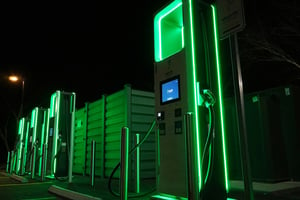This post kicks off our blog series on NEOcore technology. Over the coming weeks, we'll show you real-world use cases with measured results from actual power electronics projects—performance improvements, energy savings, weight reductions, and the business impact of better thermal management.
Heat Kills Electronics
Overheating causes 55% of all electronics failures. In power electronics, thermal management isn't optional—it determines whether your product succeeds or fails in the field.
As power density increases and form factors shrink, traditional cooling methods stop working. Heat sinks that worked five years ago can't handle today's IGBT and SiC modules running at higher power levels. The physics hasn't changed, but the demands have.
Why Cooling Is Harder Than Ever
Higher Power Density – More watts in smaller spaces creates intense heat flux that overwhelms conventional heat sinks.
New Semiconductor Technology – SiC and advanced IGBT modules enable higher switching frequencies and power levels, generating more heat in smaller areas.
Miniaturization Pressure – Customers demand compact designs, leaving less room for thermal solutions.
Cost Constraints – Engineering teams must deliver better cooling without increasing BOM costs.
Regulatory Changes – EU F-Gas regulations phase out fluorinated greenhouse gases used in many cooling systems, forcing industries toward sustainable alternatives.
These aren't isolated challenges. They compound. Higher power density in smaller packages with tighter budgets and stricter regulations means thermal design can't be an afterthought.
The Cost of Getting Thermal Design Wrong
Delaying thermal design until late in the development process creates cascading problems:
Performance gets derated to prevent overheating. Efficiency drops as resistance increases with temperature. Components degrade faster—insulation, adhesives, semiconductors all fail sooner at elevated temperatures. Heat pipes dry out. Systems fail in the field.
When thermal issues surface during testing, teams face painful choices: expensive redesigns, oversized cooling solutions that increase cost and weight, or accepting lower performance than originally specified.
The business impact is measurable: warranty claims, product recalls, delayed launches, lost market share, and damaged reputation. Competitors with better thermal management ship first and capture the market.
NEOcore Technology: A Different Approach
CooliBlade's NEOcore technology integrates thermosyphon cooling directly into aluminum heat sinks. Unlike heat pipes attached to conventional heat sinks, NEOcore eliminates thermal interfaces and integrates the entire cooling solution into a single aluminum structure.
The result: thermal conductivity 1,000× higher than standard aluminum, and performance 10× better than conventional heat pipes.
Measured Performance Improvements
| Metric | Improvement |
|---|---|
| Thermal Conductivity | 1,000× vs. aluminum |
| Performance | Up to 50% increase |
| Component Temperature | Up to 35°C reduction |
| Weight | 45% lighter |
| Component Lifetime | Multiple times longer |
These aren't theoretical numbers. They're measured results from power converter projects with real customers.
Where NEOcore Makes the Biggest Impact
Renewable Energy – String and central inverters for utility-scale solar, hybrid inverters combining PV and storage, power optimizers and microinverters for distributed generation.
Energy Storage – Battery energy storage systems (BESS) requiring consistent thermal management across charge-discharge cycles.
EV Infrastructure – Fast charging stations where thermal limits determine charging speed and uptime.
Grid Infrastructure – Smart grid inverters and grid-forming systems where reliability is non-negotiable.
Wind Power – Converters in harsh environments requiring maintenance-free operation.
Cost-Effective European Manufacturing
Performance means nothing if production costs make the solution uncompetitive. NEOcore is designed for automated, cost-effective manufacturing. Our European production facility delivers high-quality thermal solutions at volumes from prototypes to 100,000+ units annually, with expansion to contract manufacturers near major markets.
Lower weight reduces shipping costs. Simpler assembly reduces labor. Longer component life reduces warranty costs. Better thermal performance means smaller form factors and less material.
Better Cooling, Better Business
Thermal management directly impacts your competitive position. Better cooling enables higher power density, smaller products, longer lifetimes, and faster time-to-market. Poor cooling creates field failures, warranty claims, and lost customers.
NEOcore isn't just a cooling solution. It's a competitive advantage built into your thermal design.
Next in this series: detailed technical breakdown of NEOcore's thermosyphon architecture and how it achieves 1,000× thermal conductivity improvements.
Working on a power converter with thermal challenges? Contact our engineering team.
Contact our cooling experts | Learn more about NEOcore technology
